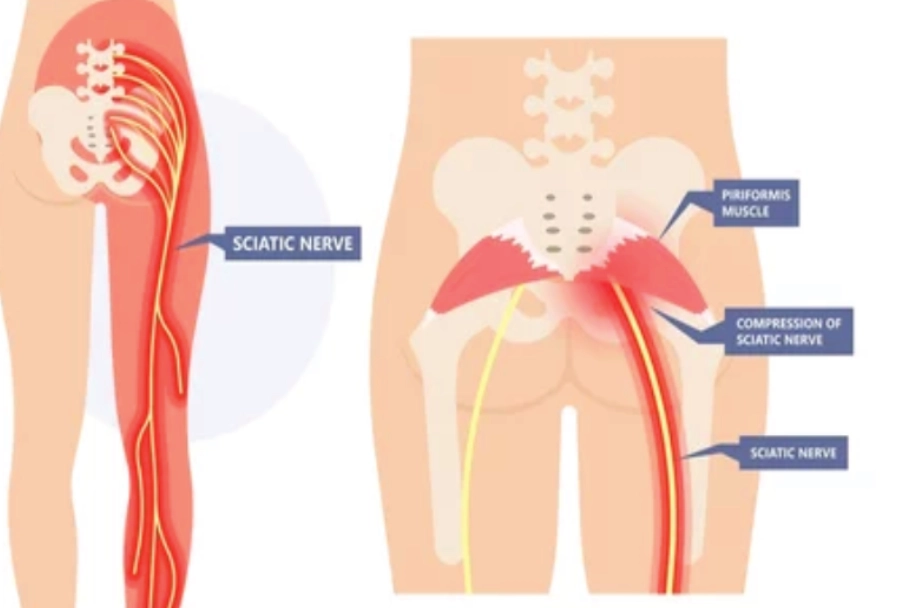Best Physiotherapy for Piriformis Syndrome You Can Trust
Trust “Best Physiotherapy for Piriformis Syndrome” for tailored rehabilitation, integrating evidence-based techniques to maximize recovery and restore independence. Our compassionate care and dedicated support aim to guide to our patients towards pain-free life, improved mobility and quality of life.
Best Piriformis Syndrome physiotherapy Doctors in Delhi, India

Physiotherapy for Piriformis Syndrome
Piriformis Syndrome Physiotherapy in Delhi
Physiotherapy for piriformis syndrome typically involves stretching and strengthening exercises, manual therapy techniques, and posture correction to alleviate pain, improve mobility, and prevent recurrence.
What is Piriformis Syndrome
Piriformis syndrome is a condition characterized by pain, tingling, or numbness in the buttocks that radiates down the leg. It occurs when the piriformis muscle, located deep in the buttock region, compresses or irritates the sciatic nerve, leading to symptoms similar to sciatica. This syndrome can be debilitating, affecting mobility and daily activities.
What Causes Piriformis Syndrome
Several factors contribute to the development of piriformis syndrome:
PIRIFORMIS MUSCLE TIGHTNESS
Tightness or hypertonicity of the piriformis muscle can lead to compression of the sciatic nerve.
MUSCLE SPASM
Spasms in the piriformis muscle, often triggered by overuse, trauma, or prolonged sitting, can exacerbate nerve compression.
ANATOMICAL VARIATIONS
Variations in the anatomy of the piriformis muscle or sciatic nerve may predispose individuals to develop piriformis syndrome.
TRAUMA OR INJURY
Direct trauma to the buttock region or repetitive activities that strain the piriformis muscle can contribute to the onset of symptoms.
POSTURAL IMBALANCES
Poor posture, pelvic misalignment, or muscle imbalances in the hip and pelvic region can increase the risk of piriformis syndrome.
Physiotherapy for Piriformis Syndrome
Physiotherapy for piriformis syndrome often includes stretching and strengthening exercises, manual therapy techniques such as massage or mobilization, postural correction, and modalities like heat or ice therapy to alleviate pain and improve mobility. Additionally, education on proper body mechanics and ergonomics may be provided to prevent recurrence.
Physiotherapy & Rehabilitation Piriformis Syndrome
Physiotherapy plays a pivotal role in managing piriformis syndrome by addressing muscle imbalances, reducing pain, and restoring function. The treatment approach typically includes the following components:
ASSESSMENT AND DIAGNOSIS:
A comprehensive assessment is conducted to evaluate the patient's symptoms, medical history, and functional limitations.
Special tests, such as the Freiberg maneuver or palpation of the piriformis muscle, may be performed to confirm the diagnosis.
PAIN MANAGEMENT:
Initially, the focus is on alleviating pain and inflammation through modalities such as ice therapy, heat therapy, or electrical stimulation.
Manual therapy techniques, including soft tissue massage, trigger point release, and myofascial release, help relieve muscle tension and reduce nerve compression.
STRETCHING AND FLEXIBILITY EXERCISES:
Specific stretching exercises targeting the piriformis muscle and surrounding hip muscles are prescribed to improve flexibility and alleviate tension.
Stretching techniques, such as the piriformis stretch or pigeon pose, aim to lengthen the piriformis muscle and reduce pressure on the sciatic nerve.
STRENGTHENING EXERCISES:
Strengthening the hip muscles, particularly the gluteal muscles, helps improve pelvic stability and reduce strain on the piriformis muscle.
Exercises such as bridges, clamshells, and hip abduction exercises are incorporated into the rehabilitation program to enhance muscle strength and support.
POSTURAL CORRECTION AND ERGONOMIC ADVICE:
Education on maintaining proper posture and body mechanics during daily activities is essential to prevent exacerbation of symptoms.
Physiotherapists provide guidance on ergonomic adjustments, such as using lumbar support cushions or adjusting workspace setup, to minimize strain on the lower back and hips.
FUNCTIONAL REHABILITATION:
Functional exercises and activities are introduced to improve the patient's ability to perform functional movements without pain.
Gradual progression of activities, such as walking, squatting, and climbing stairs, helps restore mobility and function while minimizing the risk of recurrence.
HOME EXERCISE PROGRAM:
Patients are prescribed a tailored home exercise program consisting of stretching, strengthening, and self-care techniques to maintain progress and prevent relapse.
Compliance with the home exercise program is crucial for long-term symptom management and prevention of future episodes.
ACTIVITY MODIFICATION:
Modification of activities that exacerbate symptoms, such as prolonged sitting or activities that involve repetitive hip movements, is recommended to prevent aggravation of the condition.
Physiotherapy intervention for piriformis syndrome focuses on addressing muscle imbalances, reducing pain, and improving function through a comprehensive rehabilitation program tailored to the individual needs of the patient. By incorporating manual therapy, therapeutic exercises, and patient education, physiotherapists play a vital role in helping individuals recover from piriformis syndrome and regain optimal musculoskeletal health.
FAQ ABOUT Piriformis Syndrome
What is piriformis syndrome?
Piriformis syndrome is a condition characterized by pain, numbness, or tingling in the buttocks region. It occurs when the piriformis muscle, located in the buttocks, compresses or irritates the sciatic nerve, leading to symptoms similar to sciatica.
What are the common symptoms of piriformis syndrome?
Common symptoms include pain in the buttocks that may radiate down the leg (similar to sciatica), numbness or tingling in the buttocks or leg, difficulty sitting for prolonged periods, and pain that worsens with activity.
What causes piriformis syndrome?
The exact cause of piriformis syndrome is often unclear, but it can result from activities that involve repetitive motion of the hip, trauma to the buttocks, muscle imbalances, or anatomical variations in the piriformis muscle or sciatic nerve.
How is piriformis syndrome diagnosed?
Diagnosis typically involves a thorough physical examination, including assessing the range of motion of the hip and leg, as well as specific maneuvers to reproduce symptoms. Imaging tests such as MRI or CT scans may be ordered to rule out other potential causes of symptoms.
What are the treatment options for piriformis syndrome?
Treatment may include a combination of rest, physical therapy exercises to stretch and strengthen the muscles surrounding the hip, nonsteroidal anti-inflammatory drugs (NSAIDs) to reduce pain and inflammation, corticosteroid injections to relieve inflammation, and in some cases, surgery to release the piriformis muscle. Additionally, lifestyle modifications such as avoiding activities that aggravate symptoms and using ergonomic support may help manage symptoms.
Our Treatment Process
Committed To Keep People Healthy & Safe
Our treatment process begins with a thorough assessment, followed by the creation of a personalized plan tailored to your needs. Through active rehabilitation, incorporating various evidence-based techniques, we work to promote healing and improve function. Continuous support and guidance are provided to ensure long-term success.
We start by having a thorough conversation with you about your medical history and any issues you’re experiencing. This helps us understand your unique situation.
We use state-of-the-art software and technology to analyze how your body moves and functions. This gives us a detailed picture of what might be causing your discomfort.
Based on what we find during the assessment, we create a personalized plan just for you. Our goal is to help you achieve specific outcomes, whether it’s reducing pain, improving mobility, or something else.
During your sessions with us, we use a combination of advanced technology and hands-on techniques to address your needs. This might include using special equipment or providing manual therapy to target problem areas.
We keep a close eye on how you’re doing throughout your treatment. By regularly checking your progress, we can make sure you’re on the right track and make any necessary adjustments to your plan.
Once you’ve made significant progress and reached your goals, we’ll guide you through a final session. Here, we’ll provide you with a customized digital exercise program that you can continue at home.
Even after your sessions with us are complete, we’re still here to support you. We offer virtual and online follow-up appointments to check in, answer any questions you may have, and provide ongoing guidance as needed.
At Best Physiotherapy Centre in Delhi We Follow Best Practices
Why Choose Us
We offer personalized care, crafting customized treatment plans based on your unique needs and goals. With expertise in physiotherapy and a holistic approach to healing, our team ensures comprehensive care that addresses both physical and emotional aspects of recovery.
- Personalized Care
- Experienced Professionals
- Expertise & Best Practices
- Holistic Approach
- Latest Technology
State-of-the-Art Facilities
Our facilities are equipped with the latest technology and amenities to create a conducive environment for rehabilitation and healing. From spacious therapy gyms to private treatment rooms, we prioritize comfort, safety, and accessibility for our patients.
EXPERTISE
Led by Dr. Dharam Pandey, our team comprises highly skilled professionals with extensive experience in stroke rehabilitation.
PERSONALIZED CARE
We believe in a patient-centered approach, tailoring treatment plans to address the individual needs and goals of each patient.
ADVANCED TECHNOLOGY
We harness the power of advanced technology to deliver innovative rehabilitation solutions and optimize outcomes.
COMPASSIONATE SUPPORT
We provide compassionate, supportive care every step of the way, empowering patients to achieve their full potential.
Best Physiotherapy Clinic In Delhi
At Dr. Dharam Pandey and Team, we are committed to redefining the standard of care in neurological rehabilitation. With our expertise, state-of-the-art technology, and unwavering dedication to patient-centric care, we strive to inspire hope, restore function, and improve quality of life for head injury survivors. If you or a loved one is seeking specialized rehabilitation services, we invite you to experience the difference at Dr. Dharam Pandey and Team.
Call Today
+91-9818911195 +91-9818910029
Sector-6 Dwarka, Department Of Physiotherapy [Basement 1 Manipal Hospital, Delhi, 110075
Schedule a Appointment
Note: Content provided here is for informational purposes only and is not a substitute for professional medical advice or diagnosis. If you believe you are experiencing pain or any other health-related issue, it is important to seek the advice of qualified healthcare professionals for a proper evaluation and treatment plan.









